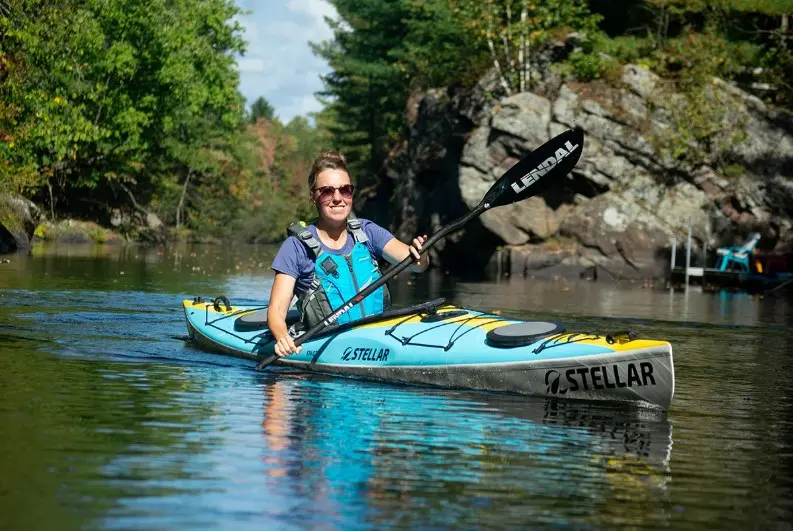Kayaking is a fantastic way to connect with nature, get some exercise, and enjoy the water—whether it’s a calm lake, a rushing river, or the open ocean. But before you grab a paddle and hit the water, one of the most important decisions you’ll make is choosing the right kayak for your needs. With so many types of kayaks available, understanding their differences can help you pick the perfect ride for your adventures.
In this guide, we’ll explore the most common types of kayaks, what makes each unique, and how to select the best one for your paddling style and environment.
1. Sit-In Kayaks
Sit-in kayaks are the classic kayak design many people picture when they think of kayaking. In these kayaks, you sit inside a cockpit with your legs enclosed within the hull of the boat.
Who are they for?
Sit-in kayaks are excellent for colder climates and longer trips because they offer more protection from the elements. Their enclosed design helps keep you warmer and drier. They also tend to have a sleeker, more efficient shape, making them faster and easier to paddle over long distances.
Pros:
- Great protection from water and wind
- More efficient for long-distance paddling
- Typically better tracking (goes straight) in water
Cons:
- Can be harder to get in and out of, especially for beginners
- Less ventilation, which might feel cramped or stuffy in hot weather
2. Sit-On-Top Kayaks
Sit-on-top kayaks have an open design where you sit on top of the kayak rather than inside. They usually have a molded seat and footwells but no cockpit cover.
Who are they for?
These kayaks are popular for beginners, warm-weather paddling, and casual outings. They’re very stable and easy to get on and off, making them great for activities like fishing, snorkeling, or recreational paddling.
Pros:
- Easy to get on and off
- Self-draining design, so water drains out quickly
- More freedom to move and stretch legs
- Great for warm climates
Cons:
- You get wetter, especially if waves splash over the kayak
- Less efficient for long-distance paddling due to wider hulls
3. Touring Kayaks (Sea Kayaks)
Touring kayaks, also called sea kayaks, are designed for longer trips, including open water, lakes, and coastal paddling. They are longer, narrower, and have storage compartments for gear.
Who are they for?
Perfect for paddlers interested in multi-day adventures or exploring vast waterways. Their design supports efficient paddling over long distances, and the storage hatches allow you to pack supplies safely.
Pros:
- Efficient, smooth paddling for covering distances
- Storage for gear and supplies
- Designed to handle waves and rougher water
Cons:
- Less stable than recreational kayaks due to narrow hull
- More expensive and less beginner-friendly
4. Whitewater Kayaks
Whitewater kayaks are specially designed for navigating rapids and fast-moving rivers. They are shorter, highly maneuverable, and built to withstand impacts with rocks and rough water.
Who are they for?
Ideal for thrill-seekers who want to tackle whitewater rapids. These kayaks require some experience to handle safely and effectively.
Pros:
- Excellent maneuverability
- Durable and built for rough conditions
- Compact size makes them easy to transport
Cons:
- Not comfortable for long paddles or calm water
- Requires skill and experience to use safely
5. Inflatable Kayaks
Inflatable kayaks have become increasingly popular because they are portable and easy to store. Made of tough, puncture-resistant materials, they can be inflated and deflated quickly.
Who are they for?
Great for casual paddlers, travelers, and those with limited storage space. Inflatable kayaks come in various styles, from recreational to touring.
Pros:
- Lightweight and portable
- Easy to store in small spaces
- Great for beginners and casual use
Cons:
- Less rigid, which can affect performance
- May require more maintenance to avoid punctures
6. Fishing Kayaks
Fishing kayaks are designed with features that support anglers, such as rod holders, storage compartments, and stable hulls to allow for casting and reeling.
Who are they for?
Perfect for fishing enthusiasts who want to access hard-to-reach fishing spots on lakes, rivers, or coastal waters.
Pros:
- Extra storage and accessories for fishing gear
- Stable and comfortable for long periods
- Some models have pedal or motor options
Cons:
- Usually heavier and less maneuverable
- Can be more expensive due to added features
How to Choose the Right Kayak for You
When deciding which kayak to buy or rent, consider these factors:
- Where will you paddle? Lakes, rivers, ocean, or rapids? Different kayaks perform better in different environments.
- What’s your skill level? Beginners may want stable, easy-to-handle kayaks like sit-on-tops or recreational sit-ins. More advanced paddlers might prefer specialized models.
- What activities do you want? Just cruising, fishing, long-distance touring, or whitewater adventure? Your purpose will guide your choice.
- Storage and transport: Do you have space to store a rigid kayak? Or would an inflatable be better for you?
- Budget: Prices can vary widely, so find a kayak that fits your needs and wallet.
Final Thoughts
Selecting the right kayak plays a crucial role in shaping your paddling adventure. Whether you’re drawn to the user-friendly sit-on-top models for relaxed outings, the swift and efficient touring kayaks for extended trips, or the agile whitewater kayaks for adrenaline-pumping rapids, knowing the different types available will guide you to the perfect choice.
Don’t forget to consider kayaks equipped with boat flotation foam, which enhances safety by improving buoyancy and preventing sinking in case of capsizing. Take the time to research thoroughly, test various kayaks when possible, and align your selection with your preferred style of adventure. Once you’ve found your ideal kayak—with the added security of flotation foam—you’ll be ready to confidently explore the waters!
Also Read-150+ Special Person in Life Birthday 🎉




